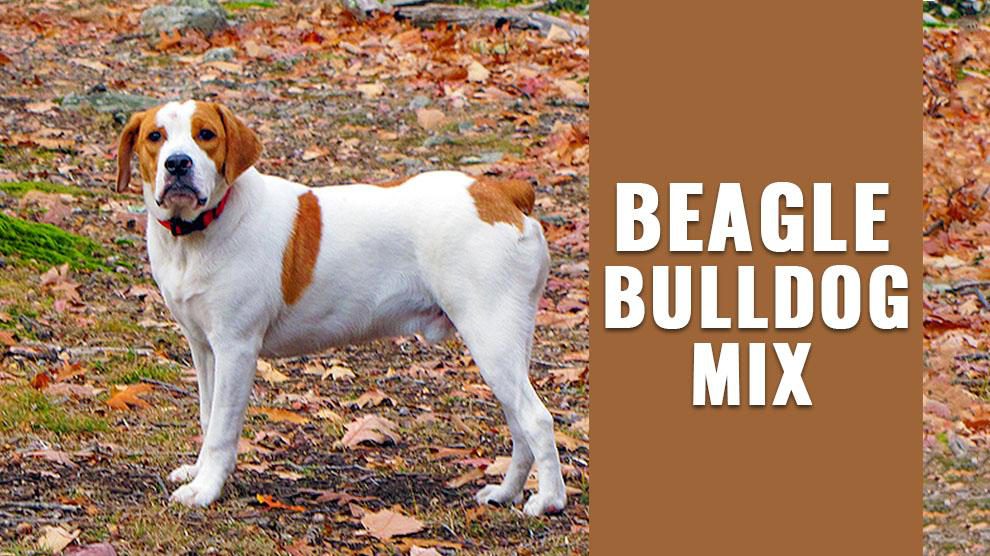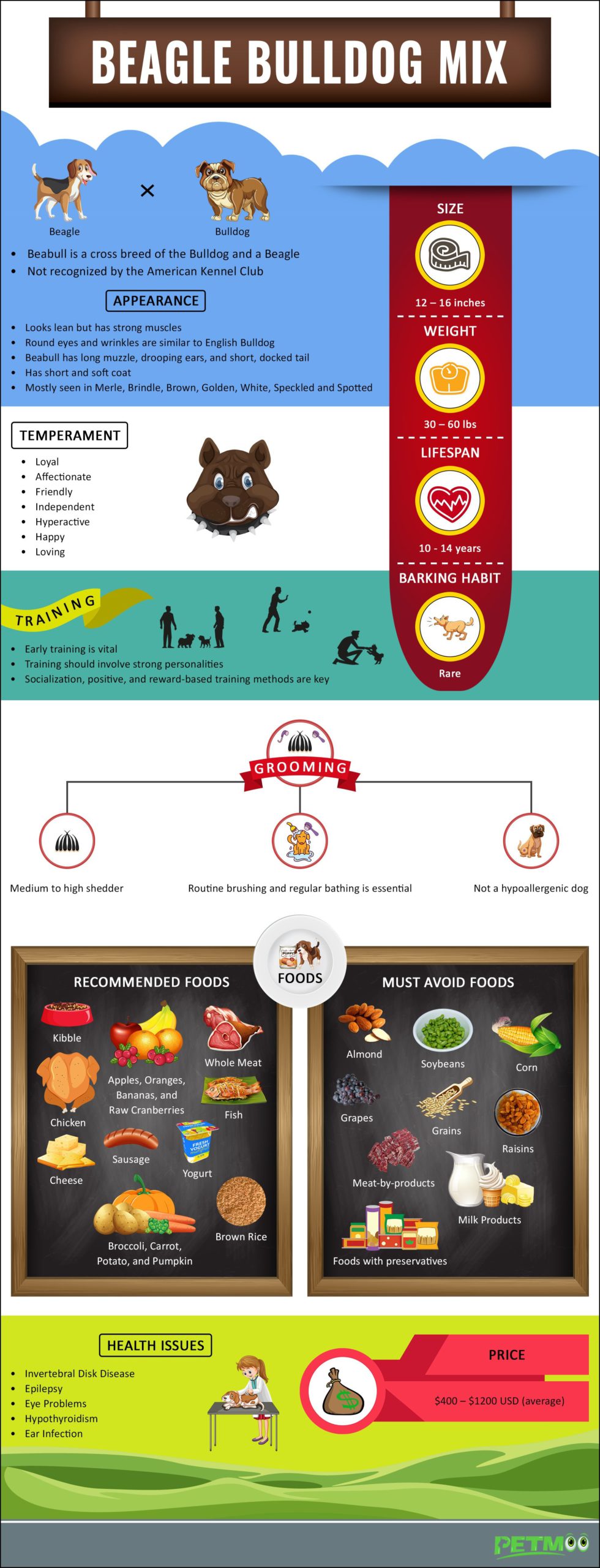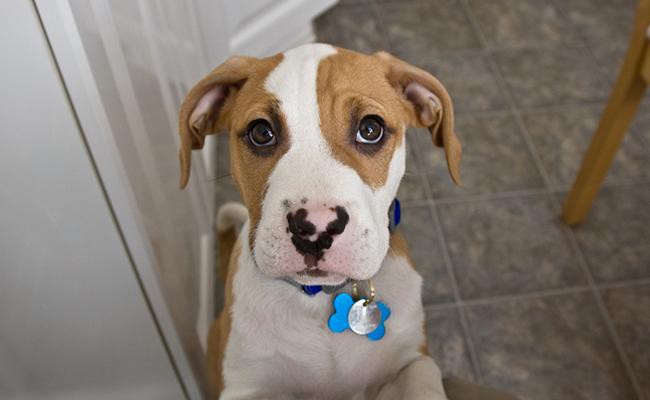Dog Pregnancy Calculator And Timeline
Do you know that the idea of cross-breeding a Beagle with a Bulldog had begun in the United States of America? Although Beabulls(Beagle Bulldog Mix) are crossbred of a Bulldog and a Beagle, their genetic makeup does not have an equal mix (50-50) of a Beagle and Bulldog.
The reason for such a situation to arise is due to the involvement of many breeders in breeding several generation crosses. Certain dog breeds are still not yet recognized by the American Kennel Club.
Beabull Facts
Coat Color
The coat colors of a crossbred Beabull are normally: Speckled, Merle, Brown, Brindle, Golden, White and Spotted.
Beagle Bulldog Mix Appearance
The Beabull dog looks lean but it is muscularly strong. It has a very short and soft coat. The eyes are round-shaped with either brown or hazel colors. It has wrinkles and an under-bite. The stated features are similar to that of an English bulldog.
It has short legs. Its tail is short and it could be docked. Beabull dogs have long drooping ears and long muzzles that appear similar to that of its Beagle parent.
Beagle Bulldog Mix Size / Lifespan
The average height of a Beabull is between 12 to 16 inches. The average body weight of this dog is between 30 to 60 lb when it is in a fully grown stage.
Barking habit
The Beabull dog barks very rarely. The average age of a Beabull is between 10 to 13 years. Dogs which are of normal health and maintained in good surroundings can be expected to live until this age range.
Beagle Bulldog Mix Training
Beabull dog is responsive to training if positive and thoughtful methods are applied. The dog expects motivation in the form of treats, rewards and encouraging words. However, the Beabull is a stubborn dog wherein this calls for very tactful handling by a trainer.
It is vital for making this dog get trained at a very age so that it shows an improvement in its character gradually. Firm minded professional trainers can only manage this dog.
Beagle Bulldog Mix Temperament
Since the Beabull dog is a cross breed between the parents, Beagle and English bulldog its temperament can be a combination.
The normal temperament of a Beabull can be:
- Friendly – Normally, these cross-bred dogs tend to adopt a friendly outlook to humans and to other pets
- Evenly tempered – It is very occasional to see the Beabull show aggressive behavior. Hence, it can be stated that this dog has a well-balanced temperament
- Independent – Usually, the dog is independent and rigid by nature. The owner/trainer can bring some changes in its behavior through proper training, which will be difficult initially.
- Family Attachment – The Beabull dogs have an inherent quality of attachment to the family members especially with the kids . They can be termed as ideal family dogs.
- Hyperactive – These dogs show sudden spells of hyperactivity and they love to play games like say, for example, hide and seek.
- Happy and loving – The Beabull is a happy puppy and always loves to move around with its owner if they are in the house
- The dog always wishes to remain loyal to its owner. This is a quality that is definitely seen in its parents
Beagle Bulldog Mix Grooming
The amount of hair shedding of a Beabull dog is between medium to high. It is necessary for a trainer/owner to groom with a routine brushing and vacuuming of the dog. They must be given regular baths using a special quality dog shampoo.
The wrinkles on the dog’s face must also be cleaned on a regular basis. The specific area requires being kept in a dry state as to remain unaffected by skin infections. Clipping the dog’s nails on a fixed periodic basis is essential.
The Beabull dog’s ears must be cleaned on a regular basis with an ear cleansing solution that can be applied by using a clean cotton ball or a damp cloth.
This step is essential to avoid any ear infection. Likewise, cleaning of the dog’s teeth at least twice or thrice in a week is mandatory to avoid dental problems.
Beabull Dog Foods
Beabull dog, a mix of Beagle and bulldog is a heavy eater like its parents.
Normally, the food bowls of these dogs are wider in size.
However, vets recommend strict diet control foods because these dogs are prone to obesity.
Foods consumed by a bulldog
- Kibble
- Fruits like apples, oranges, bananas and raw cranberries
- Vegetables like potato, carrot, pumpkin and broccoli
- Whole meat
- Chicken
- Fish
- Yoghurt
- Cheese
- Sausage
- Brown Rice
Foods to Avoid
- Chocolate
- Grapes and Raisins
- Strawberries
- Soybeans
- Corns
- Grains
- Meat By-products
- Milk products
- Foods with chemical preservatives
- Almond
Beagle Bulldog Mix Price
The average cost of a Beabull dog in the US market can be in the price range of $400 to $1200. The price is determined by the age of the dog, its health, vaccination details, breeder, location of purchase etc.
Beagle Bulldog Mix Health Problems
Must Read: Dog Diseases
1. Invertebral Disk Disease
Symptoms
- Severe pain in the neck or back areas thereby restricting the dog to walk
- Lack of feeling of pain (during the final stage of the disease)
- Hindlimb become dysfunctional
- Unable to urinate
- Reluctance in climbing or getting down the stairs
- Unwilling to do its usual jumping activity
- Spasm of the neck muscles
- Physical unrest
- Abdominal tenseness
- Hypersensitive to touch
- Ataxia
- Collapse
Causes
- Degeneration of nucleus pulposus that results in disk rupture
- Concussion
Treatment
Normally, a vet will decide the course of treatment to be given to a dog with invertebral disk after studying the extent of damage caused to its spinal cord.
- In case of slight damage to the spinal cord, some simple treatments like confinement, cage rest and pain medications are advised
- When there is a moderate level of damage to the spinal cord, certain medications like corticosteroid and non-steroidal anti-inflammatory drugs will be given
- In cases where the spinal cord is intensely affected, sheer medications will not work and surgical intervention would become essential.
The vet will advise the owner/trainer to take x-rays and other diagnostic tests. Based on the results of the x-ray and other tests, the nature of surgery to be done will be determined.
Usually, either fenestration surgery or decompressive surgery is performed on dogs with invertebral disk disease.
2. Eye Problems

Symptoms
- Reddish eyes with tears running consistently after short spells
- Formation of a cloudy appearance in the eyes
- Bumping its head accidentally into various things
- Turns the face away from bright light
- Avoids going out to newer places
- Shows anxiousness
- Squinting of eyes
- Unwilling to either run or move on the stairs
- Does not indulge in the jumping activity
Causes
- Hereditary reasons and related diseases like progressive retinal atrophy
- Diabetes
- Trauma or Injury to the eye
- Cataracts
- Glaucoma
- Corneal Ulcer due to the entry of a foreign particle or object in the eye
- Ageing
- High blood pressure
- Sudden Acquired Retinal Degeneration Syndrome
- Liver, heart and kidney diseases
Treatment
Based on the cause of the eye problem faced by the dog whether an infection or disease or old age, the veterinarian will decide on the treatment. In short, treatment will vary accordingly.
- For dogs with vision problems due to diabetes
Changes in diet and exercise are recommended. Likewise, the daily insulin shots given to the dog are also subject to change.
- For dogs with vision problems due to Glaucoma
Either medical or surgical treatment is recommended based on the stage of the disease. Most of the times, early-stage detection of glaucoma and its treatment is only proved to be successful.
- For dogs with abnormal eyelid positions and causes the lashes to rub on the eye
Surgical treatment is undertaken to correct the abnormality in the eyelid.
- For dogs that are about to lose its sight gradually and it is inevitable
Vets generally recommend the owner/trainer to train the dog early from not accidentally walking into things. This training will help the vision impaired dogs to move with the help of its other senses like hearing.
- For dogs that lose sight quickly
Some changes in the home environment could enable the dog to adapt itself after some time and move freely inside the house.
3. Epilepsy
Symptoms
- Behavioural changes
- The shakiness of the body
- Muscle twitching
- Pacing
- Wandering
- Vomiting
- Excessive Barking
- Unpredictable nature of epileptic attacks
- Paddling of legs while lying on the floor
- Loss of consciousness
- Post-seizure, involve in speedy running after some time or drink excess water
- Exhaustion leading to fatigue
Causes
- Genetic factor
- Trauma or injury to the brain
- Low blood sugar
- Imbalance of chemicals in the body
Treatment
Vets prescribe Potassium bromide and phenobarbital for treating epilepsy in dogs. Although most of the dogs show a good response to these drugs, some dogs still suffer.
These cases are referred as refractory epilepsy. In such cases, anticonvulsants like gabapentin, levetiracetam and zonisamide are utilized for treatment.
4. Hypothyroidism

Symptoms
- Depression
- Anxiety
- Head shaking
- Avoidance of daily exercise
- Slim coat
- Dry skin
- Hair Loss
- Ear infections
- Unable to tolerate cold extremities
- Gaining high body weight
- Bradycardia (very slow rate of the heartbeat)
- Anaemia
- Seizures
Causes
- Idiopathic thyroid gland atrophy
- The body’s immune system damages its own thyroid tissues suspecting entry of a foreign substance
- Poor Diet which also includes iodine deficiency
- Environment
- Affected pituitary gland
Treatment
Normally, vets advise oral medications to dogs with hypothyroidism on a daily basis. They give Sodium levothyroxine, an oral tablet that contains a synthetic T4 thyroid hormone as a daily dosage to the affected dog.
Most important of all, you must monitor the thyroxine levels in a dog’s blood. This is an indicator of proper treatment.
The frequency of daily dose could vary for each dog, some of them might require once a day while others may need twice a day. A veterinarian will do a periodic test of the dog’s blood to confirm that the hormones are functioning normally.
Usually, you should take the first test after 4 or 5 weeks and if the vet witnesses a healthy change in its thyroid hormone levels, you can lessen the frequency of the test. A major improvement must happen at the end of the third month where the thyroid hormone levels must work normally.
5. Ear Infection
Symptoms
- Head shaking
- Scratching of the ears
- Rubbing the ears on the ground
- Ears become reddish
- Swelling of the ears
- Unpleasant odour from the ear
- Hair Loss
- Unsteady walk
- Walking in a circular manner
- Hearing Loss
Causes
- Bacteria
- Viruses
- Fungus
- Mite Bites
- Allergies
- Abnormal thyroid gland
- Drug reactions
- Excessive buildup of wax in the ears
- Entry of foreign substances in the ears
- Trauma
- Autoimmune disease
- Circled style of walking
- Hearing Loss
Treatment
The usual treatment procedure for ear infections in a dog is: thorough ear cleaning by a professional and medications. Normally, veterinarians prescribe oral and topical medications.
You must treat the ear infections at a very early stage so that the ears on an overall count do not suffer damage. Certain dogs do suffer from a recurrent ear infection problem and cauliflower ear infection.
Beagle Bulldog Mix Breeders
- Smiths Beabulls
Address: 528 State Route 1035, Kittanning, PA 16201
Tel.: (724) 783-2305
E-mail: carebear016@yahoo.com - Rockin R Puppies
Address: Pottersville, MD
Tel.: (417) 256-9487
E-mail: rockinrpuppies@gmail.com - Little Puppies Online LLC
Address: Mount Vernon, OH
Tel.: (740) 497-2333
E-mail: sales@littlepuppiesonline.com
Beabull Interesting Facts
In comparison with other crossbred dogs, Beabull dogs are famous for their exceptional high jumping ability
Do you have a Beagle BulldogMix?
If you have a Beagle Bulldog Mix, we’d love to share your photos!
Let us know all about them in the comments section.






















